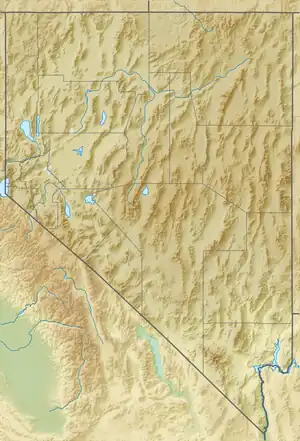| Thomas Peak | |
|---|---|
 Thomas Peak, viewed from Verdi Peak | |
| Highest point | |
| Elevation | 11,321 ft (3,451 m) NAVD 88[1] |
| Prominence | 1,080 ft (329 m)[2] |
| Coordinates | 40°37′19″N 115°23′34″W / 40.621966°N 115.392822°W[1] |
| Geography | |
 Thomas Peak | |
| Location | Elko County, Nevada, U.S. |
| Parent range | Ruby Mountains |
| Topo map | USGS Ruby Dome |
| Climbing | |
| Easiest route | From Island Lake, Class 2 scramble north up an avalanche chute and then west along the ridgeline[3] |
Thomas Peak is the second highest named mountain in both the Ruby Mountains and Elko County, in Nevada, United States. It is the thirty-fourth highest mountain in the state.[4] The peak is located about 24 miles (39 km) southeast of the city of Elko in the Ruby Mountains Wilderness, within the Ruby Mountains Ranger District of the Humboldt-Toiyabe National Forest.[2] One of the most voluminous mountains in the range, its base makes up most of the east wall of Thomas Canyon, as well as the west wall of the long curved section of upper Lamoille Canyon.
Thomas Peak and the adjacent canyon and campground is named after Raymond Thomas, a teacher at Elko High School, who led a group of hikers into the canyon in October 1916. Caught in an early snowstorm, he died while assisting his party until rescuers could arrive.[5]
Climate
| Climate data for Thomas Peak 40.6235 N, 115.3910 W, Elevation: 10,820 ft (3,300 m) (1991–2020 normals) | |||||||||||||
|---|---|---|---|---|---|---|---|---|---|---|---|---|---|
| Month | Jan | Feb | Mar | Apr | May | Jun | Jul | Aug | Sep | Oct | Nov | Dec | Year |
| Mean daily maximum °F (°C) | 28.1 (−2.2) |
27.8 (−2.3) |
32.7 (0.4) |
35.9 (2.2) |
45.0 (7.2) |
56.4 (13.6) |
66.6 (19.2) |
65.6 (18.7) |
57.0 (13.9) |
44.5 (6.9) |
34.1 (1.2) |
27.5 (−2.5) |
43.4 (6.4) |
| Daily mean °F (°C) | 19.6 (−6.9) |
18.7 (−7.4) |
22.7 (−5.2) |
26.1 (−3.3) |
34.8 (1.6) |
45.2 (7.3) |
54.6 (12.6) |
53.6 (12.0) |
45.4 (7.4) |
34.6 (1.4) |
25.4 (−3.7) |
19.2 (−7.1) |
33.3 (0.7) |
| Mean daily minimum °F (°C) | 11.1 (−11.6) |
9.5 (−12.5) |
12.7 (−10.7) |
16.2 (−8.8) |
24.6 (−4.1) |
33.9 (1.1) |
42.6 (5.9) |
41.6 (5.3) |
33.9 (1.1) |
24.8 (−4.0) |
16.7 (−8.5) |
10.9 (−11.7) |
23.2 (−4.9) |
| Average precipitation inches (mm) | 7.39 (188) |
4.49 (114) |
4.69 (119) |
5.46 (139) |
4.74 (120) |
2.15 (55) |
0.82 (21) |
0.92 (23) |
1.96 (50) |
3.07 (78) |
4.31 (109) |
6.02 (153) |
46.02 (1,169) |
| Source: PRISM Climate Group[6] | |||||||||||||
Summit panorama
References
- 1 2 "THOMAS". NGS Data Sheet. National Geodetic Survey, National Oceanic and Atmospheric Administration, United States Department of Commerce. Retrieved 2014-10-14.
- 1 2 "Thomas Peak, Nevada". Peakbagger.com. Retrieved 2014-01-28.
- ↑ "Thomas Peak". SummitPost.org. Retrieved 2014-11-12.
- ↑ "Nevada 11,000-foot Peaks". Peakbagger.com. Retrieved 2014-10-22.
- ↑ "What's in a Name?". Howard Hickson'S Histories. Great Basin College. Retrieved 2014-01-28.
- ↑ "PRISM Climate Group, Oregon State University". PRISM Climate Group, Oregon State University. Retrieved October 7, 2023.
To find the table data on the PRISM website, start by clicking Coordinates (under Location); copy Latitude and Longitude figures from top of table; click Zoom to location; click Precipitation, Minimum temp, Mean temp, Maximum temp; click 30-year normals, 1991-2020; click 800m; click Retrieve Time Series button.
External links
 Media related to Thomas Peak at Wikimedia Commons
Media related to Thomas Peak at Wikimedia Commons
_of_Thomas_Peak%252C_Nevada.jpg.webp)